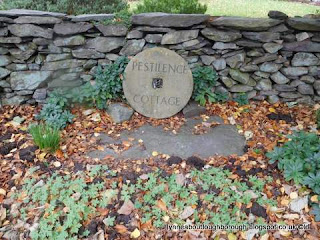A quick flick through some of the literature and I came across a chap called Percy Davenport, who had written an article about the plague, in the Loughborough Echo. A bit more of a delve revealed that Percy was an "old boy" from the Grammar School, who, whilst working at the Ministry of Health, used to copy out old documents he found, in his leisure time. Some of these are the Manor Accounts and Wills of Loughborough.
So, if Percy read what he was copying in any detail, his voice holds a lot of weight. In his 1935 article in the newspaper he wrote about "When the plague came to Loughborough", saying:
In the years 1609 and 1610 Loughborough was a place to avoid, for it was then in the grip of the deadly plague. The story told by the Parish Registers is indeed a grim one. Under the month of August, 1609, the writer sets down the simple words "A plague began on the 24th day," and for the period of the next 18 months or more, long lists of victims who succumbed are entered, each name prefixed by the letter "p".He also mentions the possibility of there being a "plague house" somewhere, which was associated with Thomas Rawlins who founded a school in Woodhouse in 1691. This school lasted until the late eighteenth century, after which it closed until it relocated to Quorn village hall where it re-opened in 1892, firstly, as a boys' grammar (Thomas Rawlins Grammar School), before becoming a co-ed school of the same name, and based in the building occupied today by the Rawlins Academy. Thomas Rawlins is reputed to have escaped the 1665 Plague of London and settled in Pest Cottage in Old Woodhouse. This cottage is still standing today, and is named Pestilence Cottage.
Percy has this to say about Pest Cottage:
Whatever may be the historical facts behind the "Plague House" of Thomas Rawlins, allusions to which have appeared in recent numbers of the "Echo", we are on solid and indisputable ground when we speak of a "Plague House" in Loughborough.The Accounts of the Bridgemasters, (who gathered funds to maintain the bridges, and the Free Grammar School and for many other local needs) were responsible to the Feoffes of the Loughborough Town Lands, and these accounts show that the feoffes took responsibility for building a Pesthouse in The Rushes, in a vain attempt to stop the spread of the plague in 1609.
Percy quotes from the accounts:
Payed to Richard Harryman on Thomas Wingkfeild hosse [house], in earnest for the newe house in The Rushes vjd [6 old pennies]."This is a formal transaction, and the builder is bound to enact the contract and build the house, which is outlined below:
Payed to Clemente Parsons for Carriadg of wood into the Rushes xjs [11 old shillings]Ironically, both Clemente Parsons and his son died from the plague in October 1610, only a few months after this contract was agreed.
Sadly, I've run out of time to carry on with this post, so pop back next week for a final installment on the plague in Loughborough, and some comments about the infamous Dead Lane!


I'd love to know more about the pesthouse on the rushes and where exactly it was. Indeed I'd love to know what the rushes looked like at that time ie what was there before the Victorian building's like Shakespeare Street.
ReplyDeleteHi George! Thank you for reading the blog - glad you've found it intriguing! I hope to be able to pinpoint the location of the Pesthouse on The Rushes. As for what might have been on The Rushes before the building of Victorian housing, I'm not sure, but when I find out I shall put the info on the blog. Lynne
Delete